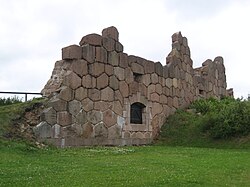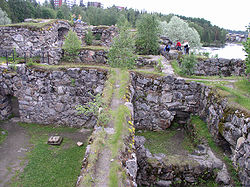This is an incomplete list of castles and fortresses in Finland.
| Name | Finnish name | Swedish name | Location | Date | Condition | Picture |
|---|---|---|---|---|---|---|
| St. Olaf's Castle | Olavinlinna | Olofsborg | Savonlinna | 1475 | Largely restored |  |
| Turku Castle | Turun linna | Åbo slott | Turku | 1280 | Largely restored |  |
| Häme Castle | Hämeen linna | Tavastehus slott | Hämeenlinna | 1320 | Largely restored |  |
| Suomenlinna | Suomenlinna | Sveaborg | Helsinki | 1748 | Largely restored |  |
| Kastelholm Castle | Kastelholman linna | Kastelholms slott | Åland | 1388 | Partly ruined |  |
| Raseborg Castle | Raaseporin linna | Raseborgs slott | Raseborg | 1378 | Partly ruined |  |
| Hamina Fortress | Haminan linnoitus | Fredrikshamns fästning | Hamina | 1720 | Partly ruined |  |
| Kärnäkoski Fortress | Kärnäkosken linnoitus | Kärnäkoski fästning | Savitaipale | 1791 | Partly ruined |  |
| Bomarsund Fortress | Bomarsundin linnoitus | Bomarsunds fästning | Bomarsund | 1832 | Ruined |  |
| Svartholm fortress | Svartholman linnoitus | Svartholms fästning | Loviisa | 1749 | Partly ruined |  |
| Ruotsinsalmi sea fortress | Ruotsinsalmen merilinnoitus | Svensksunds sjöfästning | Kotka | 1794 | Partly ruined |  |
| Hakoinen Castle | Hakoisten linna | Haga borg | Janakkala | 500 BCE | Totally ruined |  |
| Kajaani Castle | Kajaanin linna | Kajana borg | Kajaani | 1604 | Mostly ruined |  |
| Kuusisto Castle | Kuusiston linna | Kustö biskopsborg | Kaarina | 1400 | Mostly ruined |  |
| Brahelinna | Brahelinna | Braheslott | Ristiina | 1646 | Mostly ruined |  |
| Lieto Castle | Liedon linna | Lieto borg | Lieto | 1500 BCE | Totally ruined |  |
| Stenberga Castle | Stenberin linna | Stenberga slott | Masku | 1200 | Totally ruined |  |
| Liinmaa Castle | Liinmaan linna | Vreghdenborg | Eurajoki | 14th century | Totally ruined |  |
| Kokemäki Castle | Kokemäen linna | Kumo slott | Kokemäki | 1324 | Totally ruined |  |
| Oulu Castle | Oulun linna | Uleåborgs slott | Oulu | 1375 | Totally ruined |  |
| Sibbesborg | Sipoon linna | Sibbesborg | Sipoo | 1400 | Totally ruined | |
| Junkarsborg | Junkarsborgin linnoitus | Junkarsborg | Karis | 1500 | Totally ruined |

